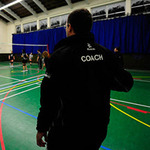I came across this drill that I think is similar in structure to ones lots of coaches use. By that I mean it attempts to replicate a sequence of actions a player will experience in the game. In this case, it’s serve-defend-attack.
I’m assuming there’s no one that the player is actually serving at on the other side, though perhaps there’s a target of some kind. It also looks like the defense ball is coming from someone hitting either from the ground on their side of the net or on a box over the net. I also suspect there’s no block when they attack.
It’s the sort of thing you do when you have limited numbers to work with – in this case possibly only 2.
Here’s my question, though. Is it actually game-like?
You might say yes, because it’s a sequence of actions that happen in a game – or at least that you want to happen in a game. That’s fair. And with only a couple of people, it’s about as close as you’re going to get to something that looks like the game.
It’s definitely not game context, though.
By that I mean it’s not happening within something like an actual game scenario. Those involve information process and and decision-making. The player at the center of this drill doesn’t actually have to do much reading or thinking, from the looks of it. This is particularly true when it comes to the dig and the attack. They know the ball will be hit to them, and exactly what comes after. No real decision-making at all – especially if there’s no block, as I suspect.
It’s even worse for the setter. They have practically no thought process at all beyond get to ball, set ball.
This is not me being critical of the drill in the context of its use. You can’t replicate the game itself with only a couple players, after all. I’d try to look for ways to introduce more randomness to increase decision-making. That would be my only recommendation for improvement.
I struggle with the idea that it’s game-like, though. Maybe it’s just me being a bit pedantic. Although this is why I tend to use game context more and more for clarity. I want to train things in game context as much as possible.
What do you think? Leave a comment below.
6 Steps to Better Practices – Free Guide
Subscribe to my weekly newsletter today and get this free guide to making your practices the best, along with loads more coaching tips and information.
